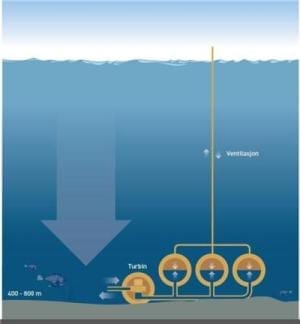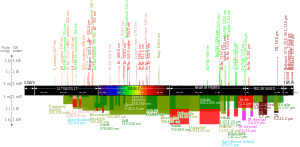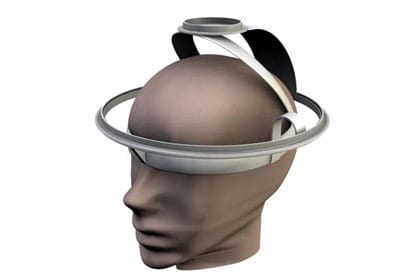
A storage power plant on the seabed
Norwegian research scientists will contribute to realising the concept of storing electricity at the bottom of the sea. The energy will be stored with the help of high water pressure.
The idea of an underwater pumped hydroelectric power plant may sound like Jules Verne fiction, but then it was hatched by a German engineer who has spent much of his professional life working in aerospace technology.
“Imagine opening a hatch in a submarine under water. The water will flow into the submarine with enormous force. It is precisely this energy potential we want to utilize,” explains Rainer Schramm, inventor and founder of the company Subhydro AS to Gemini.no. “Many people have launched the idea of storing energy by exploiting the pressure at the seabed, but we are the first in the world to apply a specific patent-pending technology to make this possible,” he adds.
He has joined forces with SINTEF in order to realize the concept.
Turbine converts energy
“SINTEF has experts in the fields of energy generation, materials technology and not least offshore and deep-water technology, which means we have all the expertise we need in one place,” says the German inventor.
To use the water pressure at the sea bed in practice, the mechanical energy is converted by a reversible pump turbine, as in a normal pumped storage hydroelectric plant.
“A pumped storage power plant is a hydroelectric plant which can be “charged” up again by pumping the water back to the upper reservoir once it has passed through a turbine. This type of power plant is used as a “battery”, when connected to the power grid,” the inventor explains.
In this pumped storage power plant turbine will be connected to a tank on the seabed at a depth of 400-800 metres. The turbine is fitted with a valve, and when this is opened, water flows in and starts turning the turbine. The turbine drives a generator to produce electricity. One can connect as many tanks as one wishes. In other words, it is the number of water tanks that decides how long the plant can generate electricity, before the energy storage capacity is exhausted.
High degree of storage efficiency
“When the water tanks are full, the water must be removed from the tanks,” Schramm explains.
This is achieved by running the turbine in reverse, so that it functions as a pump. The process consumes energy from the power grid, just as when one charges an ordinary battery. Although a bit more energy is used to empty the water tanks than can be recovered from flooding them, the degree of efficiency of this type of power plant is just as high as that of a conventional, onshore plant. According to Schramm, calculations indicate an electric storage efficiency of approximately 80 per cent round-trip.
Another advantage of the system is that equipment can be scaled according to users’ requirements, both as regards the turbine size and the number of water tanks. A plant of normal size will produce roughly 300 megawatts for a period of 7-8 hours. This is enough energy to supply just over 200,000 British households with electricity for the same time.
“We envisage that this type of storage plant will function well in conjunction with, for example, wind farms. At strong wind conditions, excess electricity is sent subsea to pump water out of the storage tanks. In periods with little wind, energy can be obtained from this underwater plant instead. The same applies to solar generation: the pumped storage power station can contribute to constant electricity production at night time when there is no sunshine to run a solar power plant,” says Rainer Schramm.
The deeper the better
In addition to the number of tanks, the sea depth also determines the effectiveness of the plant: the deeper the equipment is located, the greater is the pressure difference between the sea surface and the seabed, and the more energy is stored in a single tank.
“This is part of the reason why we want to try out the technology in Norway,” says Rainer Schramm. In his native country Germany the sea is too shallow for the system to be profitable, but there are many parts of the world where great water depths are located close inshore, such as the marine areas around Italy, Portugal and Spain, as well as North and South America.
The Latest Bing News on:
Pumped hydroelectric power
- Arizona Pumped Storage Project: Federal Energy Regulatory Commission Addresses Preliminary Permit Applicationon May 8, 2024 at 7:47 am
Pumped storage hydropower is a type of hydroelectric energy storage. It will consist of a configuration of two water reservoirs at different elevations that can generate power as water moves from one ...
- Subsidized heat pump installation is driving growth of clean energy jobs in Maineon May 8, 2024 at 7:11 am
Maine's "clean energy economy" reached 15,000 jobs at the end of 2022, posting stronger growth than the economy generally, according to a study commissioned by the Governor's Energy Office.
- REDC vows to expand RE portfolio in 2024 as part of long-term strategyon May 6, 2024 at 6:34 am
Repower Energy Development Corp. (REDC). said Monday its net income reached P172.8 million in 2023, up nearly 3 percent from P168 million in 2022 following the commissioning of two new power plants in ...
- FERC denies permit for Big Canyon projecton May 2, 2024 at 2:32 am
The Federal Energy Regulatory Commission has denied Pumped Hydro Storage LLC preliminary permits to dam Big Canyon. This decision was rendered on April 25, after pending – since 2020 – for four years.
- What is the role of hydropower in a world facing increasing drought?on May 1, 2024 at 11:44 pm
Droughts — and sudden floods which can also damage hydropower dams — made more frequent and severe by climate change, are therefore an "increasing concern" for hydropower ...
- Advanced 'high-density waterless hydro' energy plant gets green lighton May 1, 2024 at 6:53 pm
This remarkable project promises to open up zero-carbon energy storage to a broad range of areas without huge hills, delivering 2.5 times the power of water-based hydro. A pilot plant has been ...
- Utility's plan to build another dam on the Bear River on hold, for nowon April 30, 2024 at 1:00 pm
The owner and operator of four hydroelectric power-generating dams along the Bear River — three in Idaho and one in Utah — has decided to delay plans for a fifth ...
- Supreme Court dismisses L&T plea over Sharavathi tendering processon April 30, 2024 at 8:45 am
The Supreme Court on Monday rejected Infrastructure Company Larsen & Toubro's Special Leave Petition (SLP) challenging the tendering process for the prestigious Sharavathi Pumped Storage project.
- Megha Engineering and Infrastructure Secures 2,000 MW Sharavathi Pumped Storage Projecton April 29, 2024 at 8:18 am
The cost of the project is over Rs 8,000 crore, it stated.The competitive bidding process saw major players, including Larsen and Toubro LT, the company said.The Hyderabad-based MEIL won the bidding ...
- FERC blocks massive Arizona storage project in win for tribeson April 29, 2024 at 3:55 am
The Federal Energy Regulatory Commission last week rejected a massive pumped hydropower proposal on the Navajo Nation in Arizona, cementing a new agency policy to no longer advance energy projects ...
The Latest Google Headlines on:
Pumped hydroelectric power
[google_news title=”” keyword=”pumped hydroelectric power” num_posts=”10″ blurb_length=”0″ show_thumb=”left”]
The Latest Bing News on:
Pumped-storage hydroelectricity
- Azerbaijan Explores Cooperation With Chinese Firms To Boost Renewable Energy Storageon May 9, 2024 at 3:08 am
To achievethis goal, the country is embarking on various initiativesleveraging solar, wind, and hydropower technologies. However, thesuccessful integration of renewable energy into the national ...
- Arizona Pumped Storage Project: Federal Energy Regulatory Commission Addresses Preliminary Permit Applicationon May 8, 2024 at 7:47 am
Pumped storage hydropower is a type of hydroelectric energy storage. It will consist of a configuration of two water reservoirs at different elevations that can generate power as water moves from one ...
- REDC vows to expand RE portfolio in 2024 as part of long-term strategyon May 6, 2024 at 6:34 am
Repower Energy Development Corp. (REDC). said Monday its net income reached P172.8 million in 2023, up nearly 3 percent from P168 million in 2022 following the commissioning of two new power plants in ...
- FERC denies permit for Big Canyon projecton May 2, 2024 at 2:32 am
The Federal Energy Regulatory Commission has denied Pumped Hydro Storage LLC preliminary permits to dam Big Canyon. This decision was rendered on April 25, after pending – since 2020 – for four years.
- What is the role of hydropower in a world facing increasing drought?on May 1, 2024 at 11:44 pm
Droughts — and sudden floods which can also damage hydropower dams — made more frequent and severe by climate change, are therefore an "increasing concern" for hydropower ...
- Advanced 'high-density waterless hydro' energy plant gets green lighton May 1, 2024 at 6:53 pm
This remarkable project promises to open up zero-carbon energy storage to a broad range of areas without huge hills, delivering 2.5 times the power of water-based hydro. A pilot plant has been ...
- Supreme Court dismisses L&T plea over Sharavathi tendering processon April 30, 2024 at 8:45 am
The Supreme Court on Monday rejected Infrastructure Company Larsen & Toubro's Special Leave Petition (SLP) challenging the tendering process for the prestigious Sharavathi Pumped Storage project.
- County Council Offers Conditional Support to Pumped Storage Proposalon April 30, 2024 at 6:14 am
Grey County Council has voted in favour of offering conditional support of TC Energy’s proposed hydroelectric pumped storage facility to be located on the grounds of the 4th Canadian Division Training ...
- Drax invests £80 million into Scottish pumped storage hydro poweron April 30, 2024 at 3:34 am
Drax has announced its investment to refurbish the Cruachan hydro power station in Scotland to reach 480MW generation capacity.
- Permit Denied for Big Canyon Dam Near Grand Canyonon April 29, 2024 at 10:15 am
On April 25, 2024, the Federal Energy Regulatory Commission (FERC) struck down a plan to dam Big Canyon, a threat that had loomed over the Little Colorado River and the Grand Canyon region for years.
The Latest Google Headlines on:
Pumped-storage hydroelectricity
[google_news title=”” keyword=”Pumped-storage hydroelectricity” num_posts=”10″ blurb_length=”0″ show_thumb=”left”]









